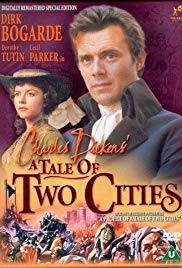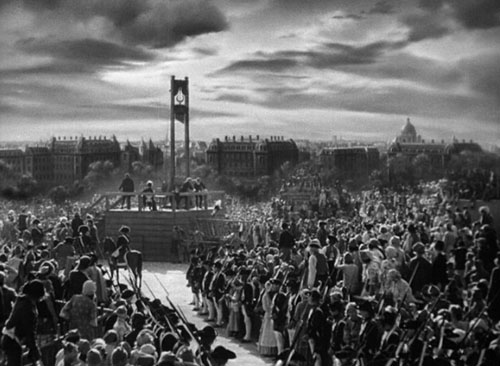The French Revolution, 1789 – 1799, was the second great democratic revolution of modern times; the American Revolution being the first. In the French Revolution, the people of an established European country, burdened with a centuries-old tradition of feudalism and monarchy, rose up and threw off the oppression of the nobility, the royalty and the clergy. In many ways, the French Revolution looked to the United States for its inspiration but different circumstances took the French Revolution beyond the American Revolution both in its reforms and in the excesses of the revolutionaries attempting to protect their hard-won liberties. The French Revolution showed the world that powerful, established and oppressive social structures could be overthrown. Its Declaration of the Rights of Man still serves as a model for modern representative government. “Liberty, Equality, Fraternity,” the aspirations of the revolutionaries, still express the goals of modern society. But the French Revolution also served as a warning that revolutionary zeal can trample on the very rights that it seeks to protect.
The absolute monarchy in France, serfdom, special privileges for the nobility, compulsory church tithes, special privileges for the clergy, imprisonment for debt, and primogeniture in the inheritance of land were abolished by the French Revolution. Instead, universal male suffrage, equal liability to taxation, separation of church and state, freedom of the press, religious freedom, the metric system, and equality of all people before the law became established principles of governance. In criminal cases, the French Revolution established the right of habeas corpus, the right to a jury trial, the presumption of innocence, the right to an attorney at trial, and the right to a fair trial. The massive estates of the nobility and the Catholic Church were broken up and distributed among the peasants.
In the first year of the revolution, the people sought to establish a moderate constitutional monarchy under King Louis XIV. But the King refused to cooperate and sought a return to royal control. In the years following 1790, the revolution was beset with opposition. The monarchist powers of Europe combined to invade France in an effort to reimpose the old order. Émigré noblemen sought a return to royal government. Monarchist uprisings took hold in various parts of the country. High officials and generals with ties to the king and the aristocracy committed treason that resulted in defeats for French armies on the battlefield. There were food shortages. The political leadership of the revolution was divided. In this situation, with the revolution in dire peril, absolute power was given to a Committee of Public Safety which came under the control of a party called the Jacobins. Under the leadership of Robespierre, the Jacobins instituted the Reign of Terror beheading any possible threat to the regime. Of the 17,000 people beheaded by official action during the Terror, 8% were nobles, 6% clergy, 14% from the middle class and 70% peasants and others charged with harming the revolution in some way, such as hoarding food, deserting from the army, supporting monarchist rebellions, etc.
Shortly after the military and domestic situation began to improve, the radical Jacobins were removed from power and were themselves beheaded. Their blood ended the Reign of Terror. However, the revolution never resulted in a stable government and in 1801 the people turned to a popular general, Napoleon Bonaparte, who promised peace and to implement the reforms of the revolution. Napoleon then created a cult of personality, had himself crowned as Emperor, and sought to conquer Europe. Napoleon also tried to establish his own royal line, marrying into one of the most powerful royal families in Europe, the Hapsburgs. Most of the reforms of the French Revolution were confirmed during Napoleon’s rule. While he was not elected, Napoleon knew that he ruled at the sufferance of the people. See Learning Guide to “Conquest”.
After the defeats of Napoleon in 1813 and 1815, various monarchies ruled France for a time. A few of these governments were constitutional monarchies in which the king’s power was shared with a parliament. After decades of struggle, democratic ideals eventually triumphed and since 1871 France has enjoyed a republican form of government traced directly to the French Revolution.
The twin democratic revolutions, first in the United States and then in France, have inspired democratic revolutions in many countries in Europe and around the globe.
England took a different course to full representative government. Limitations on the king’s power were first codified in the Magna Carta in 1215. Parliament in those early years was not powerful compared to the modern parliaments and it was dominated by the aristocracy. In the 14th century, the Parliament was divided into a House of Commons and a House of Lords, with the pre-eminent power being in the House of Lords. Parliament in England met only when called by the king for some special purpose. Until the 17th century, Parliamentary power waxed and waned depending upon the historical situation and the forcefulness and needs of the English kings.
The rights and prerogatives of the Parliament increased greatly in the Civil Wars of 1642 and 1648 which resulted in the execution of Charles I. Under the Commonwealth established by Oliver Cromwell, the monarchy and the House of Lords were abolished and Parliament ruled the country. In 1660 the monarchy returned. While there were periods of friction between the Parliament and the monarchy after the fall of the Commonwealth, the power of Parliament was never thereafter seriously in doubt. As time progressed, the powers of the Parliament were peacefully expanded. Beginning in the 18th century, the House of Commons became predominant and the king ruled through a prime minister elected by the House of Commons. However, this was still not democracy as we know it. Only the propertied classes were permitted to vote, the Anglican Church had voting representatives in the Parliament, and the borders of the districts from which members of Parliament were elected were not adjusted to reflect changing populations. Rural areas were therefore over-represented.
In the 19th century, the democratic movements which spawned the French Revolution and the threat of similar unrest at home caused England to make the House of Commons progressively more democratic. The middle class was given the vote in 1832. Universal male suffrage was instituted by 1884. In 1911 the districts were equalized by population. Women over 30 were permitted to vote in 1918 and this was extended to women over 21 by 1928. The voting age was lowered to 18 years in 1969.
The House of Commons has progressively expanded its powers to the point that it, and the prime minister who serves at its pleasure, run the country without challenge from any other institution of government. In 1999 the Labour government of Tony Blair began democratic reforms of the now toothless House of Lords.



